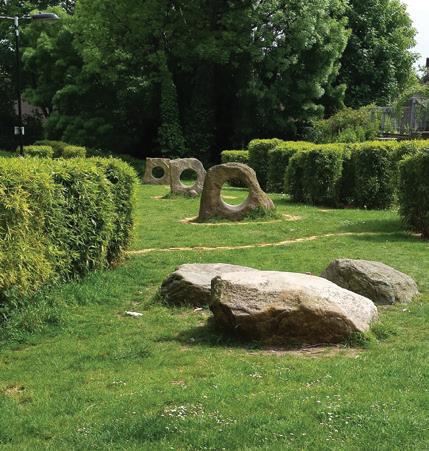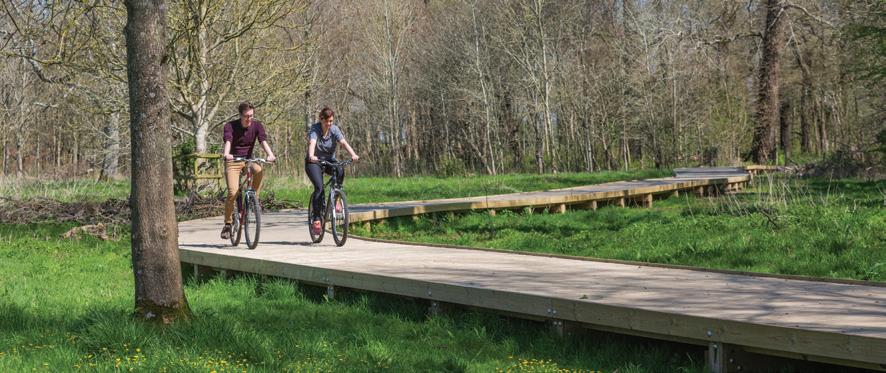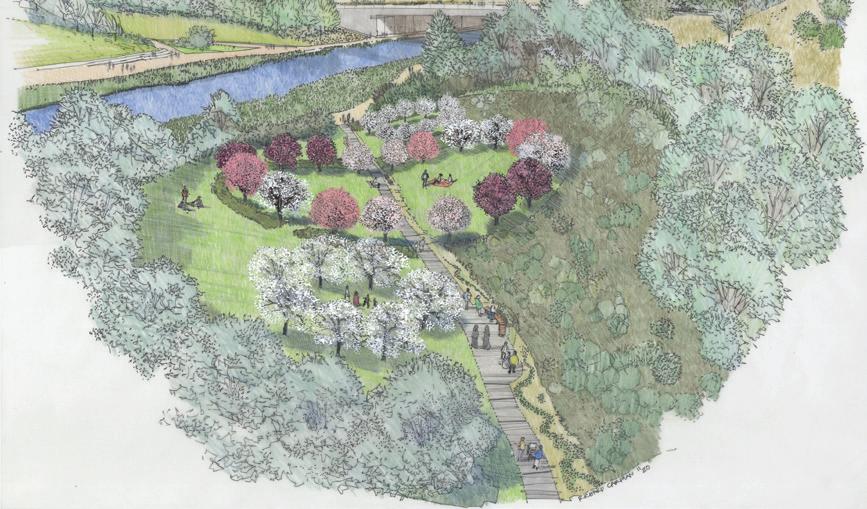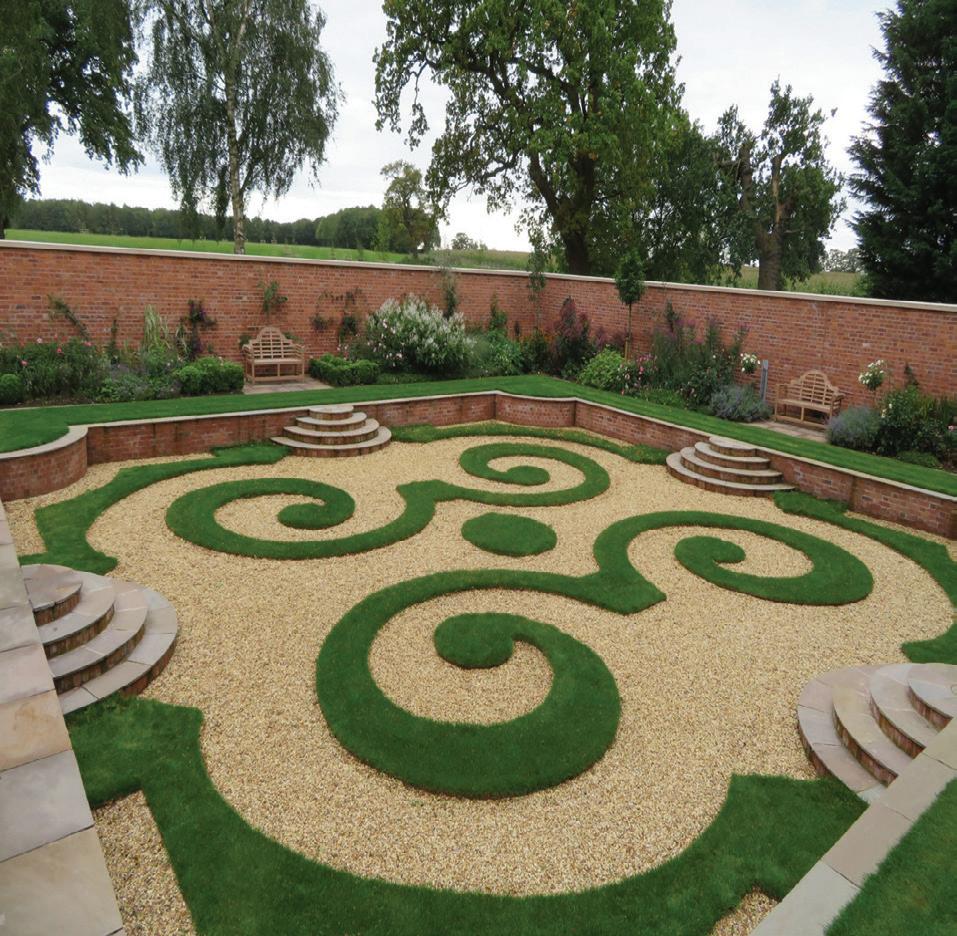
11 minute read
Re-evaluating green spaces
Green for go in the bid to boost health
A diverse cast of actors is assembling in the campaign to create and manage sustainable green spaces, Greg Rhodes reports
Advertisement
As the world learns to live with Covid-19 and its mutant offspring, nations are busy weighing up the winners and losers of the pandemic.
The move from city to country life for more of us, the future of the high street in an online retail era and homeworking offer challenges and opportunities in the climate of the new normal.
Reimagining the public realm comes high on many’s priorities as Britain addresses zero carbon targets and climate change – as does tackling a tidal wave of mental health issues exposed and exacerbated over a tumultuous and transformational year.
What is apparent now is the need for more considered, strategic approaches to health and wellbeing to benefit all sectors of society. Feeding into that vision are climate change mitigation and developing financially and environmentally sustainable settings accessible to all.
For landscapers, the terms of engagement are shifting rapidly too, as the pursuit of wider goals is forging dramatic rethinking of established solutions.
Planners and estates managers for example see a softer, more forgiving and interactive urban realm as hard surfacing increasingly makes way for greening to replace greying.
If lockdown showed us anything, it has been the importance of a sense of self-worth, family and community - and how critical access to green space, whatever size, has become in that equation for balanced, productive living across all socio-economic and ethnic groups.
As traditional roles and jobs die away, new opportunities are opening up and landscapers have a major role in what may become a dramatically different commercial climate.
Actors and stakeholders as diverse as the NHS, The National Trust, mental health charities, public health bodies, Sport England and local community and parks groups are interacting to stimulate fresh thinking and interventions to move the utility and importance of green spaces on to a higher plain to generate wider public access.
The Fields in Trust study `Re-evaluating Parks and Green Spaces` came to some startling conclusions in seeking to measure their economic and wellbeing value to individuals.
The total economic value to an individual is £30.24 a year, it found, and includes benefits gained from using their local park or green space and non-use benefits such as the preservation of parks for future generations.
Furthermore, the wellbeing value associated with the frequent use of local parks and green spaces is worth £34.2bn a year to the entire UK population was another key finding.
Parks and green spaces are also estimated to save the NHS some £111m annually “based solely on a reduction in GP visits and excluding any additional savings from prescribing or referrals”, the report concluded.
The opportunity for landscapers to work together with councils, charities and health authorities could be substantial, judging by moves underway by both The National Trust and CPRE London.
Under the Future Parks initiative, the Trust is working with partners to discover new ways to fund and manage local parks “sustainably”.
“Just as we are beginning to reaffirm the true value of open spaces to our society, the health of our public parks is under threat due to a dramatic shift in local authority funding,” it stated in its launch announcement.
Director General Hilary McGrady said: “We need to give parks a reboot and start thinking about them as essential elements of our communities in the same way we think about housing and transport.”
With National Lottery Heritage Fund and government support, the multi-million pound pioneering programme is set to “secure the future of the UK’s urban parks and green spaces”, focusing on eight urban areas.
Future Parks Initiative
Birmingham : Bournemouth, Christchurch and Poole Bristol : Cambridgeshire (countywide) Edinburgh : Islington and Camden Nottingham : Plymouth
The green space falling within the programme totals 20,000 hectares of parks, woodlands, cemeteries, allotments, playing fields and nature reserves. On top of financial investment, expertise in conservation, green Tranquility in Islington

space management, fundraising and volunteering will be shared with other councils to “ensure green spaces are continually managed”.
Within what is now a more coherent strategy for optimising the value of green spaces, measures to identify and measure the benefits they offer have been launched and already adopted.
The Health Parks initiative for example is already “gaining resonance” according to Richard Tisdall, director of landscape architects, Tisdall Associates, which unveiled the scheme two years ago.
“We aim to provide a broader vision of how parks can be better used to provide a context for co-operative working between councils, Care Commissioning Groups and public health bodies to deliver practical interventions


providing discernible improvements in mental health, physical activity and wellbeing.
“This will also address health inequalities and strengthen green social prescribing within a context of primary prevention.”
Integral to optimising existing ownership of parks is the need to produce an evidence-based approach that evaluates the benefits parks currently provide with proposals for widening them to accommodate greater public access.
“An integrated approach with public and private sectors is key,” Richard continues, “as no one group commands all the expertise required. Each will bring their strengths to the table.
“Many strands are moving forward, developing a momentum to engage the community at a profound, fundamental level.”
As part of the Health Parks initiative, the Health Parks Toolkit provides the vehicle for this change. Developed by Tisdall Associates, and assisted by the charity Parks for London and CEO Tony Leach, along with other councils including Islington and Hounslow, the Toolkit has been utilised by a wide range of UK authorities.
“The Toolkit allows parks to adopt a holistic approach and identify strengths and weaknesses,” Richard explains, “to allow councils to take a view on park facilities and benefits, ensuring communities have the full range of opportunities across their provision, rather than having everything in one park.”
This is certainly no `one size fits all` adoption, he insists. “Health policies have to respect differing local community perspectives and needs,” although the Health Parks strategy and Toolkit arguably will have value common to all regions.
Interest in the Health Parks audits is mounting across the UK, with enquiries also coming from overseas, Richard adds.
Back in London, Islington council’s Future Parks accelerator project funded a Parks for Health scheme that included the Health Parks Toolkit.
Barry Emmerson, Head of Parks for Islington and Camden, takes up the story. “My team worked with Parks for London two years ago on behalf of Islington and Camden and with the public health team,” he recalls.
The assessment of Islington’s 106 parks and Camden’s 72, studied accessibility, health promotion, physical assets such as football pitches and outdoor gyms, environmental factors and biodiversity.
“This analysis allows each of the above criteria to be address by borough, ward, park and element. Each is addressed according to whether elements are (1) present and satisfactory, (2) in need of improvement or (3) new opportunities.
“The `Current Health Status` identifies existing elements and facilities and combines elements that are `Present and Satisfactory` with those `In Need of Improvement`. Improvements and new opportunities are also identified separately,” Barry says.
“Utilising information in the Toolkit, we can identify say a group of parks in a specific ward, looking at physical health, social prescribing and mental wellbeing of the local community.”
“The report was completed in late 2020 and the findings produced in a format to embed within our capital bid process.”
Key factors centre on how park developments fit into existing health conditions and mental wellbeing of the local catchment, Barry adds. “Do they allow access to nature, offer places for quiet reflection and include woodland planting and flower borders.
“Also, can we provide opportunities for people to get involved in community gardening and volunteering and develop stronger ties with CCGs and mental health groups?”
Funding will be sought through Section 106 and community infrastructure levy on developers (improvements to roadways and so on) Barry adds. “Longer term, we will approach the NHS and CCG. If we can demonstrate benefits, we can leverage funding.”
Armed with the evidence base the Toolkit can provide, Barry foresees a major strategic role for the landscaping sector to revision park assets matching local needs.
“Covid has really shown the true value of our parks and green spaces and they are now seen as more than just good to have,” Barry says. “More people want to get involved post-Covid, and zero carbon and ecological issues moving up the agenda, the role parks and green spaces play in resolving these issues cannot be ignored.”
While momentum builds nationally to safeguard green spaces, campaigners are seeking to designate new parks in the capital, given the research that revealed London only had half the green space it needed.
In its November 2020 report, the Council for Protection of Rural England (CPRE) London identified the need for ten new ones for spaces that include rare wetlands, wildlife habitats and areas in danger of development.
Under the campaigning charity’s geographical scope, which covers Greater London and surrounding Green
Belt, are three key missions.
“We advocate protection of what we have and resisting conversion of natural to unnatural spaces such as hardstanding,” states director Neil Sinden, “more public benefit for green spaces”, which includes designer interventions to introduce better planning and layouts and “expanding green spaces.
There are competition advantages for landscape architects and landscapers in creating a public realm to accommodate that vision”.
Currently leading a coalition on the Healthy Streets Scoreboard, which involves actions to mitigate effects of traffic and other factors, CPRE London has already been active in tackling an increasingly intrusive aspect of urban life.
Working under the European Noise Directive, it partnered Tisdall Associates two years ago on enhancing green spaces, focusing on noise pollution from traffic flows in parks. The results, issued by DEFRA, revealed between 25% and 50% of London parks were impacted.
The way forward is for greater collaboration among local planning authorities, landscape designers and architects and parks, the charity believes.
“Planting hedgerows between carriageways and green spaces to create a pollution boundary to absorb vehicle emissions as well as wildlife corridors is one solution,” Neil says. “Species selection is important though, so that they are appropriate to the local setting.”
“Creating bunds to isolate areas within green spaces such as parks is another option, to create a sense of tranquillity for those using them. Victoria Park in the East End planted hedges two years ago to create secluded areas.”
Water features in urban public spaces are important going forward, he believes. “New York is a fine example, where people come to them to enjoy a nicer kind of natural noise.”
CPRE England is seeking a widely-shared vision involving local groups and the Mayor of London in a mission to fund more green development, including greater access by the public.
Pockets of progress are appearing. Grosvenor Estates a year ago began rethinking Grosvenor Square in Mayfair, following the American Embassy’s relocation to Nine Elms in 2017. The 2.5ha open garden now includes a public park.
London’s `hidden` green spaces are in CPRE London’s sights too. “Big questions need to be asked of private access to London’s gardens,” Neil notes, memorably typified in the closing moments of the film Notting Hill.
COMPACT ROBUST AND

CONSTRUCTION
LANDSCAPING
CIVIL ENGINEERING
DEMOLITION
Access all areas
Protecting the integrity of historic gardens and parklands if we allow more people to access all areas is a key consideration for custodial bodies like The National Trust, as is ensuring health and safety in such open spaces.
For example at at Wicken Fen, Cambridgeshire the Trust’s team built a new boardwalk behind the Roger Clarke hide and out to the new accessible path around the woodland walk. Completed in 2018/19, it delivers a safe, sustainable solution in an extremely environmentally sensitive landscape.
On another initiative wider green space access was at the heart of a National Trust/Sport England £4.2m match-funding partnership programme, now nearing delivery, to create ten cycle trails across its mansion properties. Begun in 2014, the programme was designed to raise usage levels by redeveloping existing paths and creating new ones, says project manager Martin Harrison-Putnam.
“These are safe, traffic-free surfaces, with wayfinders, that are really accessible for wheelchairs, buggies and mobility scooters,” Martin adds. “We transformed tired worn out paths and reclaimed historic walkways where possible, with the aim of pulling visitors out of sensitive areas and creating a springboard for opening up access to our estates.”
“We had to go through a rigorous process of local planning applications and consulting on ecology, garden history, habitats and archaeology with Natural England, Historic England and the Woodland Trust,” says Martin, who adds that current data reveal split in use of 70% walkers: 30% cycling, both showing an uplift.
If the project requirements are any indication of the scope and scale of what is to come in re-evaluating green space, landscape architects, designers and contractors have a major part to play in protecting and rethinking these treasured areas, whether rural or urban.
And with cities and built up areas in mind...
The National Trust and partners have announced plans for blossoming tree circles in cities across England, Wales and Northern Ireland over the next five years, working with local authorities to design and plant the spaces.
“The project is just one element of our ambitions to plant more trees,” says National Trust director general Hilary McGrady, “and to address Britain’s need for green space and nature where people live.”
The first circle, planned for Queen Elizabeth Olympic Park, Newham, will include 33 UK grown trees, representing the 33 London boroughs, and will provide a place to reflect on the impact of Covid-19 on the capital. Blossom-inspired spaces are also planned for Plymouth, Nottingham and Newcastle, the Trust confirms.












